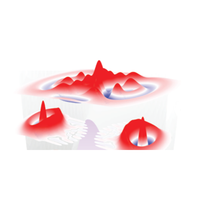Abstract
By applying a microwave drive to a specially designed Josephson circuit, we have realized a double-well model system: a Kerr oscillator submitted to a squeezing force. We have observed, for the first time, the spectroscopic fingerprint of a quantum double-well Hamiltonian when its barrier height is increased: a pairwise level kissing (coalescence) corresponding to the exponential reduction of tunnel splitting in the excited states as they sink under the barrier. The discrete levels in the wells also manifest themselves in the activation time across the barrier which, instead of increasing smoothly as a function of the barrier height, presents steps each time a pair of excited states is captured by the wells. This experiment illustrates the quantum regime of Arrhenius’s law, whose observation is made possible here by the unprecedented combination of low dissipation, time-resolved state control, 98.5% quantum nondemolition single shot measurement fidelity, and complete microwave control over all Hamiltonian parameters in the quantum regime. Direct applications to quantum computation and simulation are discussed.
7 More- Received 28 December 2022
- Revised 18 May 2024
- Accepted 9 July 2024
DOI:https://doi.org/10.1103/PhysRevX.14.031040
Published by the American Physical Society under the terms of the Creative Commons Attribution 4.0 International license. Further distribution of this work must maintain attribution to the author(s) and the published article’s title, journal citation, and DOI.
Published by the American Physical Society
Physics Subject Headings (PhySH)
 Focus
Focus
New Quantum Effect in Textbook Chemistry Law
Published 3 September 2024
The observation of quantum modifications to a well-known chemical law could lead to performance improvements for quantum information storage.
See more in Physics
Popular Summary
A prototypical model in quantum mechanics is that of a massive particle in a symmetric double-well potential. The rate at which the particle moves from one well to the other is important for multiple applications, including predicting the rate of nuclear reactions as well as the decoherence rate of quantum information stored in such a system for quantum computation. However, experimentally tuning the double-well potential and preparing excited quantum states in it is difficult. Here, we realize an experimental platform that does just that.
Our prototypical double-well system consists of a quantum electromagnetic oscillator in which photons attract each other while subjected to a squeezing interaction (generating pairs of photons). By measuring the spectrum of the system up to ten excited states, we find that, as the squeezing strength is increased, the spectrum of the anharmonic oscillator morphs into pairs of degenerate states—a signature of tunneling in a double-well potential. We also observe that the coherence lifetime of the ground-state manifold increases in steps as the squeezing strength increases. This brings to light a new effect of general interest: the quantum regime of Arrhenius’s law, which describes thermal activation across a barrier.
Our results reveal how out-of-equilibrium quantum circuits can create new control mechanisms in quantum computation and simulation, showcasing an experimental test bed. Furthermore, the strongly enhanced coherence times along with the fast quantum control and high-fidelity readout leave our system poised for implementation in proposed quantum computing architectures.




